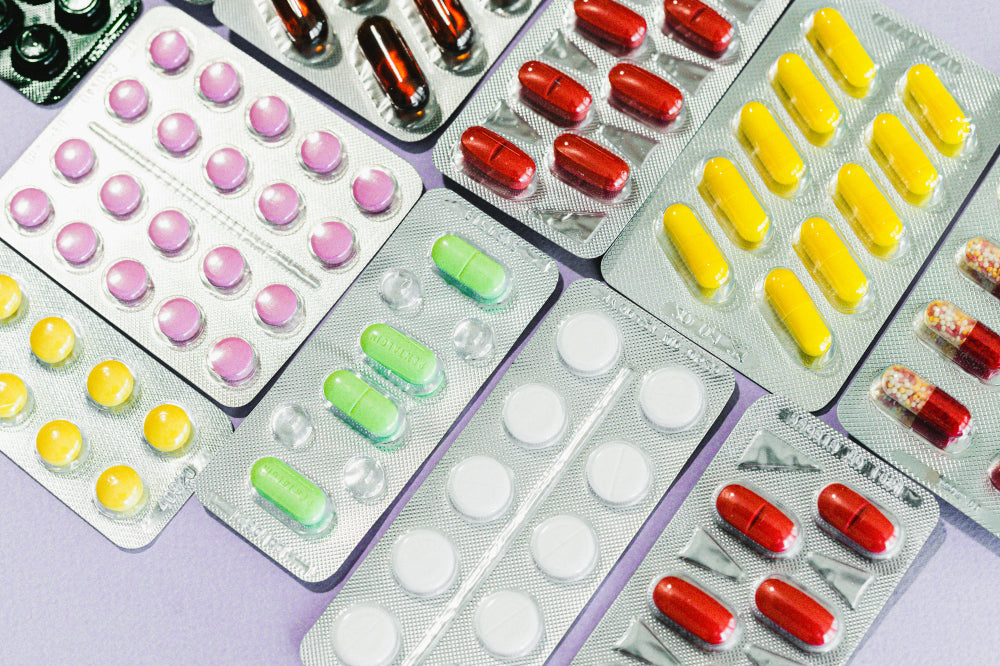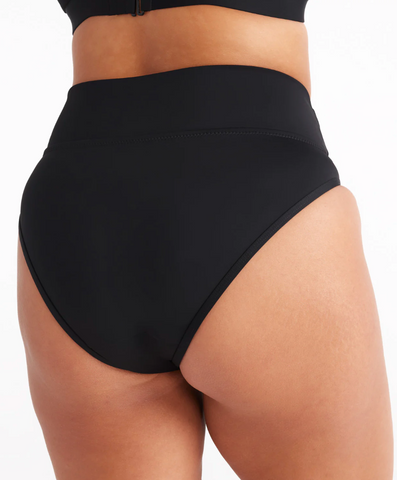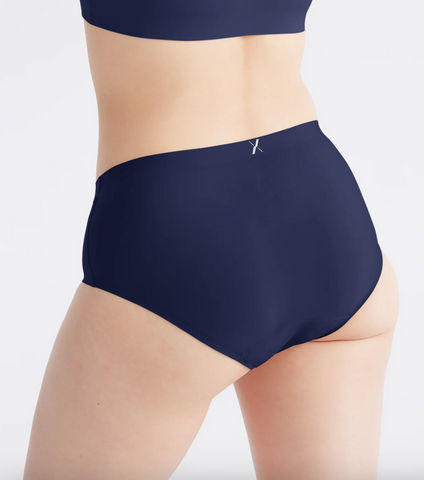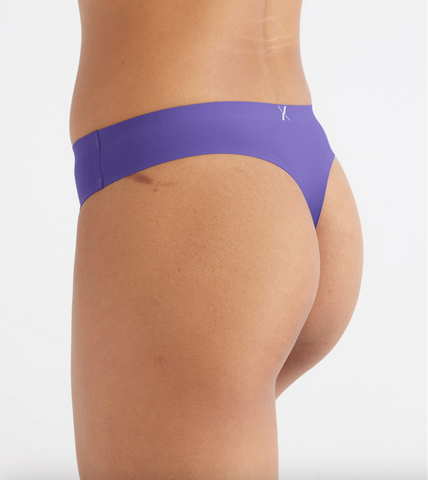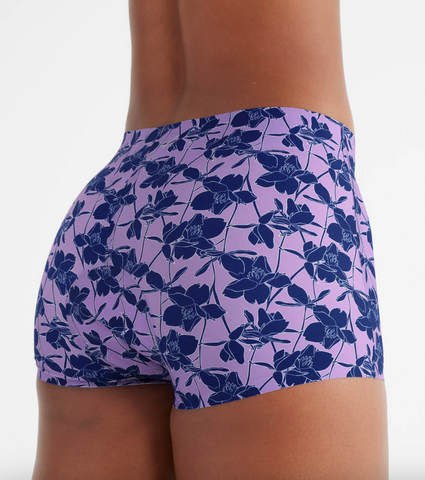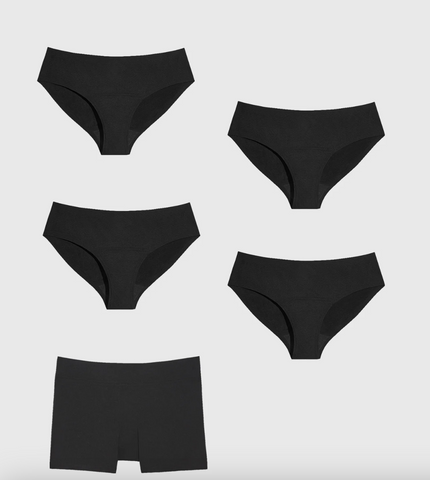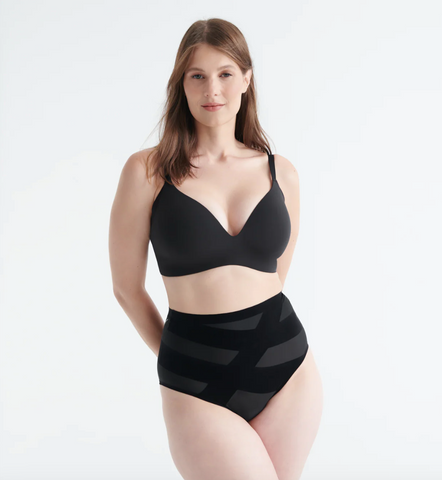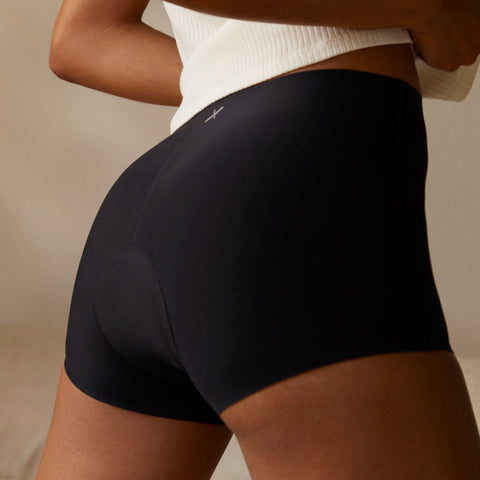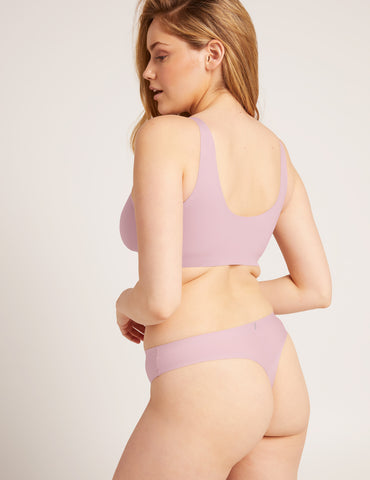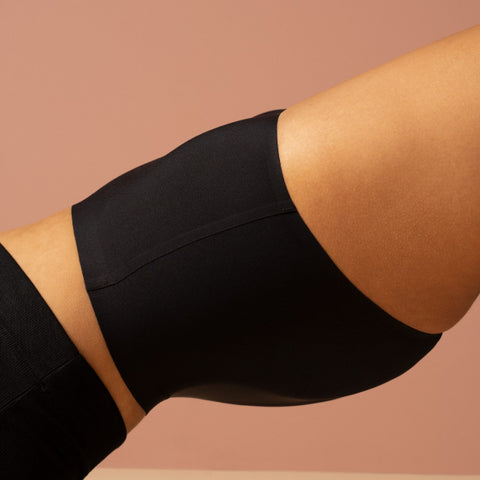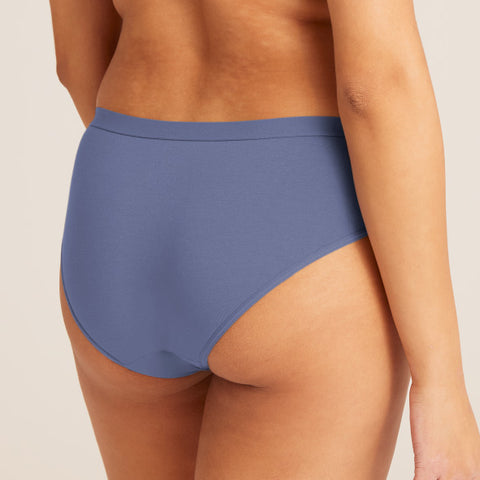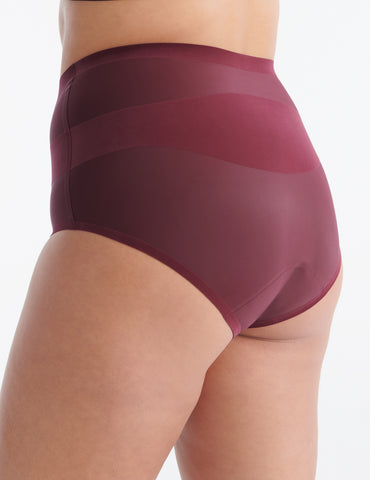Period panties might be new to you. So, when you’re looking into period undies you’re likely to wonder: How do they work?
Period underwear may look just like regular underwear but it is built with specific layers of fabrics to trap and hold menstrual blood. That means no leaks and no need for other period products (though you may choose to still use other products with period underwear.)
Good question! You may feel like there’s some impossible witchcraft going on, but these undies are the next evolution in feminine hygiene. But before we get into how it all works, let’s take a look at just how far we’ve come...
Then & Now: A History of Period Products
Then: The Same Old Stigmas
For many decades, methods of managing menstruation went unchanged, with pads and tampons being the main products used.
Although they continued to evolve, tampons went on the market in the 1940s. After the introduction of adhesive pads in the late 1960s, innovation pretty much stopped.
This is shocking when you consider half of the world’s population menstruates. But when you also consider how taboo menstruation has been until very recent times, it’s not altogether surprising.
Now: Innovative New Products Like Period Underwear
Thankfully, we finally feel like those times are behind us. There are definitely interesting innovations hitting the market when it comes to menstruation. And period undies are by far one of the most exciting (and sustainable!)
But after years of using the same period products and solutions, it can be difficult to make a change. It’s important for all of us to trust the menstrual protection we choose. So, if you’re contemplating trying leakproof undies, it’s a natural question: How the hell do they work?!
How Do Period Undies Work?
There are different brands of period undies on the market and they’re all designed slightly differently, with their own styles and innovations.
The secret design of the technical fabric used to make these panties are kept under tight wraps by these companies.
The Secret to Period Panties Is in the Fabric Layers
When people first encounter period underwear, they often expect bulky undies. It can be a little head-wrecking to imagine these thin, wearable, and (yes!) cute panties doing a good job absorbing menstrual blood when 'free bleeding.'
Knix’s Leakproof Undies act like a barely-there built-in panty liner.They will feel slightly different than your regular underwear but without the bulk of a large pad.
We recommend using leakproof products as your only period management product or as backup leak protection used in conjunction with menstrual cups, pads, or tampons… basically whatever you’re most comfortable with.
Not All Period Underwear is The Same
Just like tampons and pads, period panties come in a variety of styles. The technology can differ from brand to brand. So spend some time looking at the individual specifications of any undies you’re considering purchasing.
Nobody knows your period better than you. Whether you have a light flow or heavy flow, use period underwear as your only solution or in conjunction with other products… it’s your choice. You may even make different decisions for different days of your cycle, like on heavy flow days.
Even though our super leakproof underwear can absorb menstrual blood, some people experience exceptionally heavy menstrual flow, clotting, or ‘flooding’. For some, then, period underwear serves best as a back-up on heavier days or overnight. But for the majority, it’s all you need.
It may take some time to find your perfect solution. But regardless of your flow and menstrual cycle, period undies can definitely lend a helping hand!
Okay… But Why Are Period Undies Better?
There are many compelling reasons to consider using period undies to absorb menstrual blood.
Comfort & Confidence 💃
Period underwear won’t force you to compromise on comfort or style. In fact, they can be comfortable and pretty! You don’t need to resort to wearing those ratty old panties that you’re okay with staining.
On lighter days, period underwear can liberate you from panty-liners. It’s also worth noting that insertables (like tampons) aren’t comfortable for everyone. So period undies open up another option.
This confidence is especially needed for teens who are still getting used to their period and flow. They may also be in class or at camp for longer periods without bathroom breaks.
Moreover, familiar realities for older women like blood-stained sheets can be embarrassing for teens who have to deal with parents. So the protection offered by period underwear helps them not only with the logistics of period management but helps offset accompanying anxiety too.
Save Some 💰
Feminine hygiene products are not cheap and many simply cannot afford them (it’s known as period poverty). It’s exciting to think how period undies could revolutionize periods for women worldwide. Especially those who may not have access to, or be able to afford expensive disposable products.
Let’s face it: None of us are daydreaming about the tampons on our monthly shopping list! While you may have to initially invest in a few pairs of period underwear, over time those saved dollars can definitely add up!
Your Period, Your Choice 💪
In general, more choice is better. Period underwear and other alternative period products have broken the ‘dry spell’ of innovation in period products.
This creates more choice, which empowers people with periods, young and old. But it also means there’s more discussion about periods, period health, and products. This is going a long way to decreasing the stigma and shame that surrounded periods for so long.
For instance, did you know that the modern-style menstrual cup first emerged in the 1930s but there was low adoption because women were too squeamish about coming into close contact with their bodies and their own menstrual blood? That’s part of the reason tampons with applicators were such a hit when they emerged.
So that there’s appetite and interest for products like the menstrual cup and period underwear is a sure sign that we’ve become more open and accepting of these conversations and experiences. And this will lead to women being more in touch with their entire cycle, and confident to judge something’s not right.
How Long Can You Wear Period Underwear?
You can wear period underwear all day, every day (whether you’re on your period or not). Many women love their Knix so much they replace all their undies! They’re great for all of life’s little leaks.
But there are limits on how much different styles of period underwear can absorb.
Does Period Underwear Work in Combination with a Tampon or Menstrual Cup?
Whether you feel ready to make the full switch to period underwear or prefer to use it as a backup with other products, like a tampon or a menstrual (period) cup is completely your call.
Many customers start using period underwear as a backup product but find over time that their confidence grows and they realize they can rely on it entirely. Indeed, many end up even replacing their normal underwear and choosing to use period underwear every day (it's great for absorbing sweat or light bladder leaks too!)
You can also make different decisions on different days or for specific events when you don't want to take any risks. It's ultimately your menstrual cycle and your choice.
How Do You Wash Period Underwear?
It’s natural to think that such technical undies will require special care. A lot of lingerie is “hand wash only”. But period underwear isn’t necessarily so fussy.
Again, different manufacturers will have different care instructions. And it’s definitely worth paying attention to when you’re making a choice. After all, nobody wants to get home and realize they’ve got some high-maintenance undies on their hands!
Knix Leakproof Underwear is as low maintenance as it gets. You simply machine wash them on a cold water cycle (aka gentle or delicate cycle), with mild detergent. You can was your period pants the other clothes. We advise against using bleach. Then lay them flat to dry.
It’s important to note that undies are not completely stain-proof! So, we also recommend giving them a quick rinse before tossing them in the washing machine.
Ready to Try Period Underwear?!
If you’re ready to try Period Underwear, check out our selection here.
The patented technology built into our underwear locks in moisture helps get rid of odor and stops leaks. Designed to be both safe and effective.
Leakproof undies are perfect for people who experience light bladder leaks, wear panty liners regularly, or are concerned about excess sweating. Just wear, wash, and repeat, and you’ll have one less thing to worry about!
Wearing Period Underwear: Our Top Picks
Naturally, we think you can’t go wrong shopping from any of our Period Underwear range of products. Go for your usual favorite style of underwear, whether that’s a bikini, boyshort, thong, or high rise. But, here are some of our top picks:
Best Thong: Super Leakproof Thong
The Super Leakproof Thong - switch from relying on disposable products to wearing incredibly comfortable and machine-washable underwear.

How it fits:
The thong provides a mid-rise silhouette with minimal bum coverage. The ultra-thin & absorbent gusset is 8-9” long, providing confident coverage in front and behind. The fabric is designed to feel snug at first but relax with wash and wear for a perfect fit.
What reviewers say:
“I can't believe I waited so long to give these period panties a try. They work great, they look good, and they're super comfortable -- absolutely NO bulky pad/diaper feeling & NO soggy feeling between your legs. I purchased a few super leakproof thongs & a few regular leakproof ones, and I was pleasantly surprised by how well these did their job. I was able to get thru my entire workday without having to think about my period, and that's a beautiful thing. I will NEVER be going back to disposables, that's for sure!”
“Finally a thong I can wear with confidence! This is the first thong I've found that offers more than 'light protection'. The colour, style, fit is perfect. It's so comfortable. I need more!”
Size options:
XS to XXXXL, and everything in between.
Best Period Panties for Sleeping: The Dream Short
The Dream Short is a super-comfy sleep bottom with built-in coverage featuring patented leakproof technology.

How it fits:
The Dream Short is designed to comfortably hug your body and stay in place overnight, you can wear it as a pajama bottom or underneath your regular sleep get-up.
What reviewers say:
“One heavy night per month... I never slept well because I was worried about leaking through to the sheets and I slept on a towel that night. These dream shorts are awesome and alleviated all of my concerns. I slept GREAT and these shorts did their job!”
“I bought two pairs of the dream shorts to wear at night while on my period. It was SO nice going to bed not worrying about what position I was laying in or if I would wake up to a leak on the sheets! I’ve worn them now through two periods and I couldn’t be happier that I finally decided to try them.”
Size options:
XS to XXXXL, and everything in between.
Best for Every Day of Your Period: Heavy Flow Period Kit
Get confident protection for your whole cycle - even your heaviest days - with our Heavy Flow Period Kit. This kit includes:
- 4 pairs of Super Leakproof Underwear
- 1 pair of Dream Shorts - our comfy and confident sleep short designed for overnight period protection.

What reviewers say:
“My period comes hard and fast and so the Heavy Kit is perfect for me. I hated having to wear maxi pads all time and even felt a little embarrassed sometimes. I finally feel comfortable and confident on my period even though I'm a heavy bleeder. Thank you Knix!”
Size options: XS to XXXXL, and everything in between.
Best for Gentle Shaping: CoreLove High Rise
Beauty meets function with the CoreLove High Rise, an innovative high-rise leakproof underwear. Velvet compression bands help give your core some extra love, support, and stability.
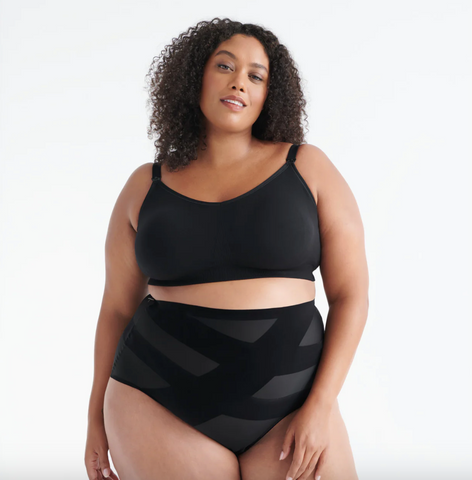
How it fits:
Sits at the natural waist and provides medium coverage through the bum. Features an extra long gusset.
What reviewers say:
“Really helps with endo cramps.”
“These period panties are absolutely incredible! I got my period today and I normally have fairly bad cramps the first day. I put these on and they have helped my cramps so much I have not even needed to take medicine to get through it today! So good. They are less stretchy and a little harder to get on because of the core love band but so so worth it! 10/10 would recommend!”
Size options:
S to XXXL, and everything in between.
Written by Jane Flanagan — Updated on April 2, 2023.
We hope you found this post informative — but remember: we’re not doctors and this post is not medical advice! While all posts are fact-checked and well researched, we always recommend you chat with your doctor about any questions or concerns you might have regarding a medical condition. We’re here to support and educate, but never with the aim of disregarding professional medical advice you’ve been given. Phew, now that that’s out of the way, you can go on living unapologetically free.
]]>











